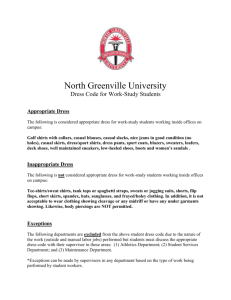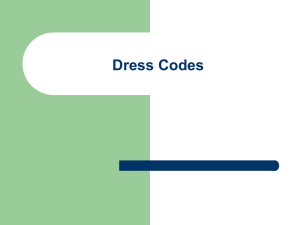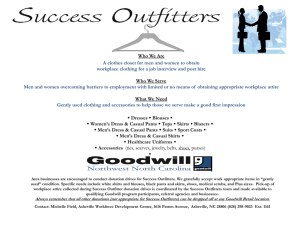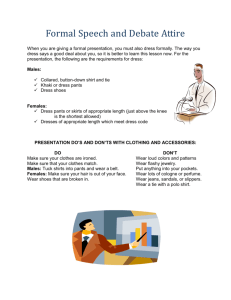Professional Attire for Men
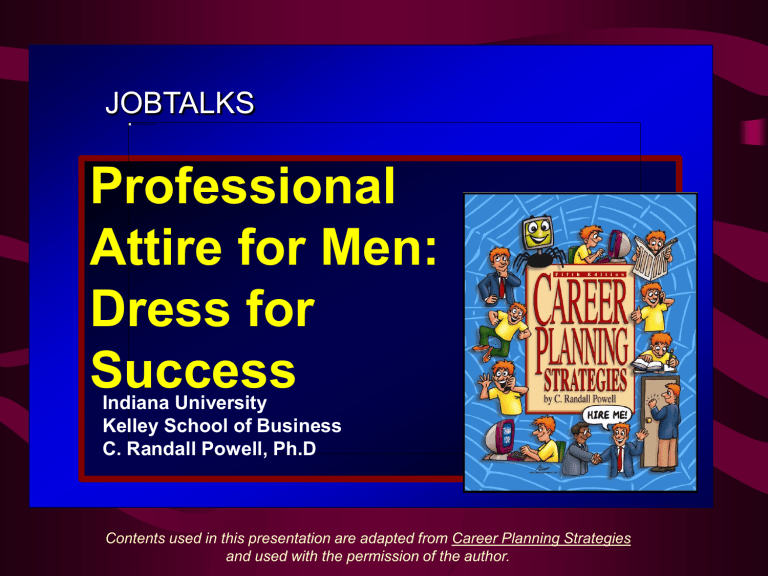
JOBTALKS
Professional
Attire for Men:
Dress for
Success
Indiana University
Kelley School of Business
C. Randall Powell, Ph.D
Contents used in this presentation are adapted from Career Planning Strategies and used with the permission of the author.
Men’s Dress:
Business Professional and Casual
How should you dress once on the professional assignment? How should you dress for your interview?
Professional Dress for Men:
Professional and Casual
Professional Dress Is Common in the Work World
Professional: The Suit
The first impression
ALWAYS has the most impact …
Suit Basics
Remember:
Match your style to the organization’s culture -- for instance, finance is more conservative, advertising more adventurous
Suit Fabric
Be a little conservative…please!
AVOID:
Sharkskin, “shiny” fabrics, poplin, corduroy, and other more casual fabrics
Suit Care
It doesn’t require a valet…
… just a little knowledge
Suit Fit
“If it feels good, wear it”
Wearing the Suit
looking good = feeling good
The Shirt Tale
Long sleeve white shirts preferred, light blue for a more casual look
NEVER short sleeves
If in a “preppy” work environment, button down collars okay-otherwise, plain collar with stays
Don’t store things in your dress shirt pocket
Wear a tee shirt under dress shirt: keeps shirt from itching : protects shirt from perspiration adds body to dress shirt
Never wear a wrinkled shirt -- have dress shirts professionally laundered if you do not press them yourself using spray starch
Tie One On
TIP: For illustrated instructions on tying these knots, try www.menswearhouse.com
Just say “No”…to bow ties
If the Shoe Fits
MEN: NEVER - that is, NEVER -- show some leg. When you are seated, with your legs crossed, ONLY socks should show .
Accessories - Less is More
The boardroom isn’t for skateboarding, and the office suite isn’t a rave so:
NO earrings, NO necklaces, NO studs, NO bracelets.
The Rules of the Game - DO...
• Accommodate your dress to the employer’s environment.
• Not sure? Dress up a notch rather than down.
• When in doubt, go more conservative.
• Remember, your dress says who you are.
• Buy less, buy classic, buy the best .
Strategy: Choose one of the highest ranking individuals in your company -- CEO, CFO, CIO -- and emulate their style.
The Rules of the Game - DON’T...
• Use short socks – ugh! Go for mid-calf or knee-highs.
• Wear wrinkled shirts – you want that crisp, professional look
• Skip the belt. Empty belt loops are slovenly.
• Wear casual shoes, or shoes with wellworn heels.
• Never wear both braces and a belt.
• Wear a brown suit to an interview.
• Jangle when you walk – keep the jewelry and pocket contents to a minimum.
Professional Casual:
Walking A Fine Line
Casual
“Business casual” is difficult to judge
Observe and emulate the top person in the company hierarchy.
The first step is to dress a notch down from full-fledged business professional
“Casual” does NOT mean “sloppy”:
Sport coats and slacks
Less formal ties or even no ties at all
All clothing worn in the office should be clean and pressed
Skip the walking shoes, tennies and Air Nikes
Professional to Casual
Taking it down a notch…
Sport Coats
Slacks
Business casual slacks work in the office and after hours
Shirts
Collars, turtlenecks – but not crew necks
Business Casual:
In General….
• Follow the “Dos” and “Don’ts” for
Business Professional dress.
• Keep an eye on the fashion choices of those who set the organization culture…do not worry about just being part of the herd, let your classic sense of style and your work set you apart.
• When in doubt, dress up a notch.
• If you are not sure something is appropriate, then it probably is not.
Business Casual:
Check it Out….
This is okay….
….and this is NOT
!
EVALUATION
QUESTIONS
1. I found the presentation material easy to understand.
2. This discussion session increased my knowledge of the subject presented.
3. I will be able to use some of the
Information from this session in the future.
• USE:
– a. Strongly agree
– b. Agree
– c. Disagree
– d. Strongly disagree
– e. Don’t know
4. The presenter was well prepared for this discussion session.
5. This presentation should be repeated in future semesters.
If you would like to learn more, Career
Planning Strategies textbook will supply additional information on this topic.

